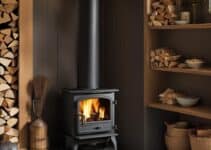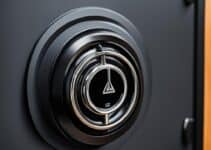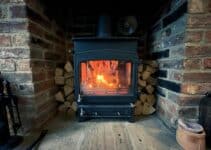My fascination with the intricate workings of log burners has led me to appreciate the significance of their components, particularly the log burner baffle. Integral to both the log burner function and design, this discrete metal plate is a stalwart guardian of efficiency, nestled within the heart of the stove.
From my observations, the baffle’s role is twofold: it champions the stove’s heat retention capabilities and stands as a bulwark against the premature escape of warmth through the flue. This vital part is crafted from resilient materials such as cast iron or steel, embodying durability in the face of searing temperatures.
My perpetual curiosity ensures that I scrutinise the minutiae of log burner design, thus recognising the baffle’s pivotal part in safeguarding the longevity and safety of the appliance. It is not merely a mechanical feature; it epitomises the profound thoughtfulness embedded in every woodburner’s blueprint.
The Critical Role of a Baffle in Your Log Burner
When I consider the intricate architecture of a woodburning stove, I am often reminded that each element plays a pivotal role in its operation and efficiency. One such component that stands out is the baffle – a seemingly simple yet essential part of log burner design. Its significance can’t be overstressed; whether you’re a seasoned wood burner enthusiast or a new owner looking to understand log burner parts in-depth, recognising the value of the baffle plate is crucial for optimal performance and safety of your stove.
Understanding the Baffle’s Function
The baffle plate function in a woodburning stove is multifaceted. Primarily, it serves to increase the heat output by trapping hot air from the fire inside the stove, which ensures that more heat is radiated into the room instead of being lost up the chimney. But the baffle’s role doesn’t stop there – it also facilitates the process of secondary combustion where waste gases are reignited, making the burning process more efficient and eco-friendly. This utilization of otherwise wasted gas underscores my commitment to both efficient heating and environmental responsibility.
Design and Materials of a Baffle Plate
Log burner components such as the baffle plate are designed with durability in mind. In my experience, a plate constructed from robust materials like steel or vermiculite is common, which can withstand high temperatures and contribute to prolonged stove life. The design is such that it promotes proper airflow while also protecting the top of the stove from the intense heat of the fire.
Consequences of Operating without a Baffle
To operate a woodburning stove without a baffle is to invite a host of problems. The unchecked heat can cause damage to the stove’s internals, while the direct contact between the fire and the flue can ignite creosote build-up, leading to hazardous flue fires. The loss of fuel efficiency is another concern; without the baffle, more fuel is consumed to achieve the same level of warmth, increasing costs and environmental impact. As a conscientious user, I find that ensuring the integrity and presence of the baffle is an essential part of my stove maintenance routine.
In summary, the baffle is not merely an added accessory but an irreplaceable component in your log burner’s anatomy. It reinforces the stove’s functionality, promotes environmental sustainability, and embodies the essence of a well-designed heating system. Its care and maintenance should thus be considered a priority for any user looking to get the most out of their woodburning experience.
Identifying and Resolving Issues with Your Log Burner Baffle
As a woodburner operator, I am acutely aware that regular log burner maintenance is crucial for both safety and efficiency. Baffle warping, resulting from overfiring or improper ash management, poses significant risks. There’s nothing quite like the unsettling discovery of a warped or poorly fitting baffle in the midst of peak operation seasons.
To mitigate these issues, I recommend a conscientious approach to woodburner operation. It includes observing practices such as correct fuel loading and air vent regulation to prevent excessive heat build-up. My advice is to be vigilant about the signs that may indicate the baffle is compromised:
- Bowing or distortion of the baffle
- Physical splitting or cracks in the material
- A loose fit that allows smoke and flames to bypass the baffle
Furthermore, to prevent erosive damage from ash accumulation, which can exacerbate baffle warping, cleaning should be a part of routine maintenance. Removing ash build-up not only extends the life of the baffle but also enhances the overall performance of your log burner. I strongly advocate for regular service checks that can spot potential faults before they turn into major failures.
- Inspect the baffle for deformities or damage every few weeks.
- After every use, ensure that ash is removed from the baffle area.
- Seek professional advice if any signs of warping or damage are detected.
I cannot overemphasize the importance of addressing any issues promptly. A neglected or damaged baffle not only hinders performance but could nullify the woodburner’s safety mechanisms. Always consult your log burner’s manual for specific guidance on baffle care and follow manufacturer endorsed procedures.
In conclusion, addressing baffle issues is not merely a matter of maintenance but a commitment to safe and efficient woodburner operation. By staying proactive, one can enjoy the warm, crackling ambiance of a well-maintained log burner with peace of mind.
Determining When to Replace Your Log Burner Baffle
As a conscientious homeowner keen on maximising log burner efficiency, understanding the lifespan of your log burner’s components, such as the baffle, is essential. Recognising when to invest in baffle replacement not only bolsters the performance of your heating appliance but also contributes to log burner longevity.
Signs of Baffle Wear and Tear
Visual inspection is paramount when assessing the condition of the baffle. If you notice symptoms of damage such as warping or holes, immediate measures should be taken. An improperly seated baffle doesn’t just hinder efficiency; it’s a precursor to potential safety hazards and underlines the need for a swift response.
Regularly scrutinise your baffle for any signs of wear and tear. A baffle in disrepair could drastically diminish the efficacy of your log burner and, more significantly, present substantial fire risks.
How Frequent Usage Affects Baffle Longevity
Intensive use inherently subjects your log burner baffle to quicker deterioration. I make it a point to monitor my stove’s activity closely, as the more frequently a burner is used, and at higher intensities, the more critical it becomes to regularly check for erosion and distortion.
Below, I’ve outlined an approach to sustaining your log burner’s baffle, focusing on early detection of issues which could signal the need for a replacement:
- Conduct biannual assessments following seasons of heavy usage.
- Keep an eye out for any physical deformations on the surface of the baffle.
- Check that the baffle sits correctly as per the manufacturer’s specifications.
- Maintain a record of burning habits to judge the frequency and need for baffle inspections.
The integrity of a baffle plays a pivotal role in the safe and effective functioning of a log burner. The following table summarises key indicators which, upon identification, may signal the need for baffle maintenance or replacement.
| Indicator | Description | Recommended Action |
|---|---|---|
| Misalignment | Baffle does not fit securely or is unevenly placed. | Reposition or replace if continuous misalignment occurs. |
| Physical Damage | Visible signs of warping, cracks, or holes. | Replace the baffle to ensure safety and efficiency. |
| Erosion | Thin spots or perforations developed over time. | Consider replacing before complete failure occurs. |
Upholding these practices not only fortifies the log burner’s efficiency but also assures you peace of mind, knowing that each fire lit is safe, controlled, and effective for heating your home.
Improving the Efficiency of Your Log Burner
Efficiency in woodburning is paramount to maximise the heat output and minimise waste. I believe that realising optimal log burner efficiency is achieved through meticulous maintenance and a considered approach to using your stove’s resources. My commitment to these practices ensures sustainable and cost-effective heating. The baffle is not merely a component but the cornerstone of an effective log burner, directing smoke and trapping heat to bolster performance. My dedication to its upkeep is non-negotiable, gauging the critical importance of its condition to the overall operation of the stove.
Furthermore, I always fuel my fire with seasoned wood, recognising that its lowered moisture content is essential for efficient woodburning. As a result, my log burner produces more heat output, less creosote build-up, and a cleaner burn, reducing environmental impact and delivered with unrivalled warmth. Equally fundamental to efficiency is the regular cleaning of the chimney. An unobstructed flue allows for optimum air flow, which is vital to ensure complete combustion and the desired draw of air into the burner.
In an effort to mitigate the challenges posed by environmental variables such as wind, which can adversely affect the draw and cause backdrafts, I’ve found that installing a chimney cowl can be remarkably beneficial. This adjunct to log burner accessories serves to stabilise the chimney’s pull and prevent downdraught, thus promoting a consistent and controllable burn. Such proactive steps have undeniably enhanced not only the safety aspects of operating my log burner but also its economic viability—leading to a more enjoyable and responsible woodburning experience.
Source Links
- https://www.thestovehouseltd.co.uk/blogs/news/heat-making-your-baffle-warp-stove-tips-help-advice-from-your-local-stove-shop-in-midhurst-west-sussex-nr-chichester-haslemere-puborough
- https://www.directstoves.com/our-blog/common-causes-of-stove-smoking-and-how-to-prevent-it/
- https://www.albanyecohouse.com.au/blogs/news/about-the-baffle-plate-in-your-wood-heater


